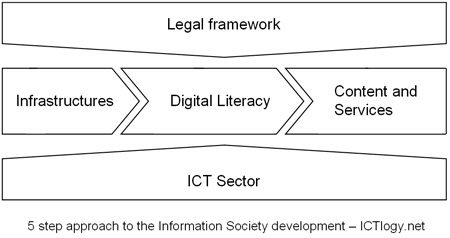Disheartening analysis that Jakob Nielsen does in his November 2006 Alertbox Digital Divide: The Three Stages. He there defines the Digital Divide in three stages:
- Stage 1: Economic Divide
- Stage 2: Usability Divide
- Stage 3: Empowerment Divide
I can understand — we all do this — that he tries to bend the term Digital Divide and reshape it under a usability light — Nielsen’s field of expertise. But I think this “reshapening” goes way too far. I fully agree with the Economic Divide stage. I would call it Access to Infrastructures (hard, soft and connectivity), but it’s the same thing with a different name.
My first objection is in splitting his so-called Usability Divide from the Empowerment Divide. Actually, this is all about Digital Literacy, which can be defined in several levels, as many as you’d like to: technological literacy, informational literacy… functional literacy. But it is absolutely about the same thing: using ICTs. I mean, it’s okey separating the different skills that compound digital literacy, but this should be a starting point, not an ending one.
Thus, I find a second objection, and surely the most serious one, that is forgetting — intended or not — that there is much more to the Digital Divide than money/access and literacy/capacity building. The existence of an ICT Sector is crucial in the correct development of a local Information Society, specially in fields such as Education (ICT enhanced or just e-Learning) or e-Administration and e-Goverment. If ICTs are to be used as a locomotive to foster the economy, then the ICT Sector becomes, simply, a must.
Of course, a local Information Society must be driven by an accompanying legal framework that monitors and drives its development, be it by just regulating the activities that take place in the Network, be it through public policies devoted to this goal.
And last, but not least, there’s something even more important than all those described digital divides or stages: digital content and digital services. Simple as it might sound, with no content and no services, there’s no use having skilled people tapping on state of the art computers. And this is, by far, one of the most important pitfalls nowadays, almost unsurmountable in most developing countries — more than the economic divide, I’d dare say: while we “have” one laptop per child, there are just 3,102 articles in the Swahili Wikipedia vs. the 1,621,894 of the English Wikipedia.
Summing up, this is my 5 step approach, as stated on a previous article:

So, I liked Jakob Nielsen entering the field of ICT4D and the Digital Divide. But least I’d expected was some humbler approach, avoiding that holistic aim.
If you need to cite this article in a formal way (i.e. for bibliographical purposes) I dare suggest:
Peña-López, I. (2007) “Jakob Nielsen’s Digital Divide: The Three Stages” In ICTlogy,
#41, February 2007. Barcelona: ICTlogy.
Retrieved month dd, yyyy from
https://ictlogy.net/review/?p=504
Previous post: A Reader on Open Access for Development
Next post: puntoOrg, the spanish TechSoup
 RSS feed for comments on this post.
TrackBack URI
RSS feed for comments on this post.
TrackBack URI

